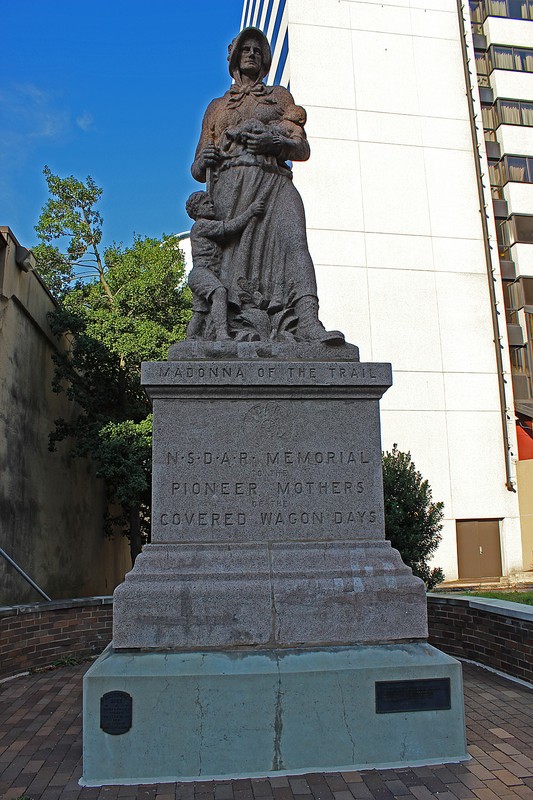Madonna of the Trail (Bethesda, MD)
Introduction
Text-to-speech Audio
Images
August Leimbach, Madonna of the Trail, Bethesda, Maryland

Backstory and Context
Text-to-speech Audio
National DAR Commission chairperson Arlene B. Nichols Moss was inspired by Portland, Oregon’s 1905 Sacajawea monument to commission Madonna of the Trail statues to be placed in the 12 states through which the “Old Trails Road” passed. Sculptor August Leimbach envisioned a scene in which she is looking for her husband whom she believes to be in danger. Like other Pioneer Mother statues erected during the late 1920s, the 12 DAR statues balanced strong, active roles for women with softer maternal symbolism.
One Madonna of the Trail statue was erected in each of the states through which the National Old Trails Road passed. The statues were cast from algonite (a form of cast stone produced from a mixture of crushed marble, Missouri granite, stone, cement and lead ore) at the cost of $1,000 per statue. The statues were placed along key white migration routes, such as the early-19th-century National Road (later U.S. Route 40) and Santa Fe Trail (later the infamous Route 66). But the precise location of the monument within each state was selected based on both the site’s historical significance and the influence of local DAR chapters. Maryland's statue was placed not at the start of the Old National Road, but the site of the first American military road.
The 12 Madonna of the Trail statues are among the best-known of nearly 200 pioneer-themed public monuments in the United States. But many local residents have questioned the placement of a Madonna of the Trail in urban Bethesda, Maryland. She seems to garner little attention except when she stands in the way of urban redevelopment or threatens to fall onto passing commuters. A sinkhole that developed beneath the statue in 2004 caused her to lean like the famous Tower of Pisa. Nonetheless, city leaders remain committed to maintaining the statue within their community’s business district. In 2001, Cumberland, Maryland, sought to raise its own visibility as the easternmost point on the Old National Road by adopting Bethesda’s Madonna of the Trail.
'Not in my lifetime,' responded Bethesda Chamber of Commerce President Jack Alexander. 'You all are welcome to come look at it,' he said, ‘but you’re not leaving with our madonna.’1
The Madonna of the Trail was so important to civic identity that it was featured on Bethesda's logo, but that logos and the statue it depicts remain largely unknown to residents of what has become a major urban core for the Maryland suburbs of Washington, D.C.
Sources
Carol and Michael Heffernan, Medlicott. ""Autograph of a Nation": The Daughters of the American Revolution and the National Old Trails Road, 1910-1927." National Identities, vol. 6, no. 3 (2004), 233-260.
Bauer, Fern Ioula. The Historic Treasure Chest of the Madonna of the Trail. Springfield, Ohio. J. McEnaney Printing, 1984.
Daughters of the American Revolution. Twenty-Second Report of the National Society of the Daughters of the American Revolution: March 1, 1918, to March 1, 1919. US Government Printing Office, 1921.
Peters, Helen. "Madonna of the Trail." New Mexico Magazine. December 1993.
